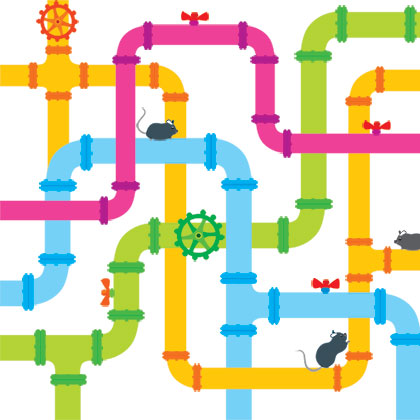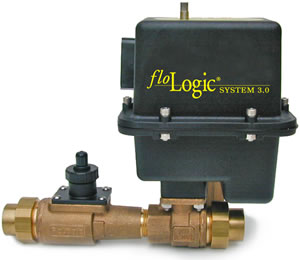
Building a New Industry: The FloLogic Story
In 1986, Chuck De Smet and Douglass Phillips stumbled on an interesting problem. The CFO at the company where they worked went home one evening to find the ceiling of his kitchen, living room and dining room destroyed. Water was all over the place and his house was unlivable. While he was at work, a toilet on the second floor had cracked, flooding the entire house with water.
For the next few months, the CFO had to live in a hotel with his family and pets while the house was repaired. Though the insurance company covered the damage, the experience was tremendously painful. For Chuck and Douglass, they felt like they were living through the situation along with the CFO. So like other good entrepreneurs, they tried to figure out a solution.
The Product
Over the next decade, the pair of would-be entrepreneurs discovered 11 different patents related to home leaks, but no one else building a company. Contacting all of the patent holders, they tried to figure out why a viable product hadn’t been brought to market yet. They even hired a team of telemarketers to figure out if plumbers and wholesalers had seen anything else that would solve the leak problem. But, with nothing else in the market, they realized their only choice was to build a company themselves.
And so was born the “plumbing circuit breaker” industry. Founding FloLogic in 1996, Chuck and Douglass raised angel capital and hired an engineering firm to design a ‘circuit breaker’ that would shut off water if the flow suddenly massively increased. But it wasn’t easy. As Chuck explained, “At the time, it was extremely difficult to find a sensor that could detect relatively small volumes of water.” But eventually they figured out a solution that worked.
When I asked what they would do again if they started another company, Douglass said “I would repeat how we outsource everything we possibly can.We outsource manufacturing, engineering, etc to companies that can support us. If one of their people quits, we’re not left with a gaping hole in the company.”
Finding the Market
As with every company, FloLogic took awhile to find their footing while chasing a ‘blue ocean’. “Being first is tough because you’re introducing a concept to the market. Most people don’t know they need it and that’s even more challenging,” Chuck told me about their first few years, “When I first went into market, insurance companies had no idea what plumbing leaks were costing them in terms of payments.”

By 1999 things started to click. The product they built impressed the editors at Popular Science and one of their Best Product of the Year awards. Then luck really turned their direction. “Early in the 2000s, Farmers was sued for $32M by lady in Texas. When insurance companies looked at plumbing leaks, they found that 25% of all claims and 22% of home owner claims paid out per year were plumbing related,” explained Chuck De Smet, “The claims cost between $9-10 billion a year. After that claim, our phones started ringing.”
Building a Company
But, FloLogic was faced with a conundrum. Should they pursue a consumer play and go after individual homeowners or should they target the insurance companies who were feeling the acute pain? Chuck explained their strategy, “If you’re trying to hit the consumer market, there’s no limit to the amount of money you can invest in marketing. We’re not a venture play. We don’t fit IT or health care or anything else sexy.”
Looking back, Chuck did note that he “would get more money on the front end. We’ve been a just in time financing company. Trying to build shareholder value all the way and get money only when we really need it,” he explained, “As we’ve seen, capital can dry up really quickly. We needed money after the dot bomb and it was hard to raise capital. Either get money or have visibility to that money through a fund or institution for when times become more lean.”
With a leaner balance sheet, FloLogic decided against pursuing the consumer market. Instead they followed the ‘hub and spoke’ model, focusing on getting insurance companies to do their marketing for them. “Hitting the insurance company at the right spot and use their infrastructure to grow is cost effective for us,” Douglass explained, “they send billing inserts to policy holders, educate their agents on the value of our product, etc.”
Where They Are Now
The model has led to a wide base of recognition. As Douglass told me, one of his relatives received their inserts because she’s an insurance agent who should be selling the product to her clients. Mainly growing by working with the insurance companies has lead to a very productive use of capital and has keep the company with their ethos of oursourcing as much as possible.
Through the early 2000s, FloLogic saw spikes when insurance companies were getting sued for mold issues. Then, as new home builds were rapidly accelerating in the mid-2000s, they found a great market. But when the bubble burst, they had a bit of an adjustment like many other firms. Now, with the recession well behind them, FloLogic is growing again.
Looking back on the last two decades of work, Chuck and Douglass realized they’ve created an entire industry. There are now dozens of other companies covering different parts of the market, though they still own the high end and have a great reputation. FloLogic is ready to accelerate their growth with the right partners, by developing new product lines and expanding their sales force. Through connections they’ve made on Axial, they’re close to taking the next step and are excited for the future possibilities.